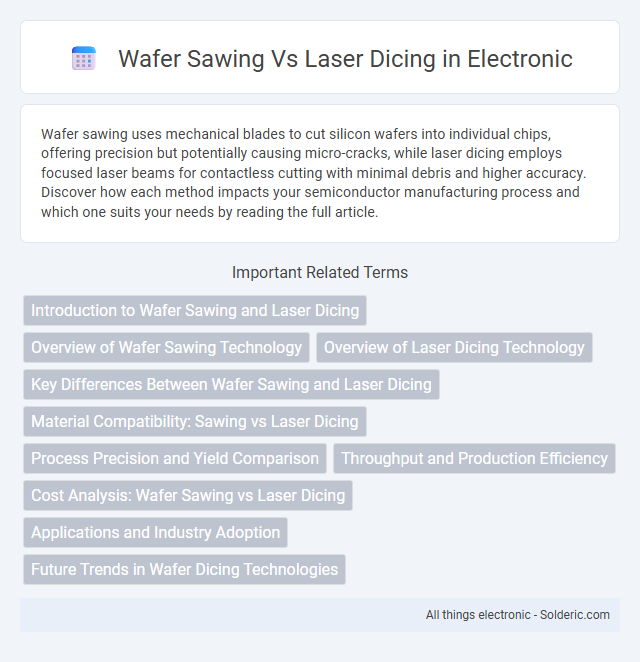Wafer sawing uses mechanical blades to cut silicon wafers into individual chips, offering precision but potentially causing micro-cracks, while laser dicing employs focused laser beams for contactless cutting with minimal debris and higher accuracy. Discover how each method impacts your semiconductor manufacturing process and which one suits your needs by reading the full article.
Comparison Table
| Feature | Wafer Sawing | Laser Dicing |
|---|---|---|
| Process | Mechanical cutting using diamond blades | Non-contact cutting using focused laser beams |
| Material Impact | Physical stress, potential chipping | Minimal mechanical stress, precise cuts |
| Kerf Width | Typically 30-50 um | As low as 10 um |
| Cut Quality | Moderate, may require post-processing | High precision, smooth edges |
| Speed | Slower, dependent on blade speed | Faster, controlled by laser parameters |
| Material Compatibility | Silicon, glass, ceramics (limited) | Wide range including brittle & thin wafers |
| Heat Affected Zone (HAZ) | Minimal heat generation | Possible thermal effects, requires optimization |
| Cost | Lower initial investment, higher maintenance | Higher initial cost, lower maintenance |
| Applications | Standard semiconductor wafer dicing | Advanced packaging, ultra-thin wafers, MEMS |
Introduction to Wafer Sawing and Laser Dicing
Wafer sawing uses diamond-tipped blades to mechanically cut semiconductor wafers into individual dies, offering precise and cost-effective separation for various chip sizes. Laser dicing employs focused laser beams to ablate material with minimal mechanical stress, enabling higher precision and reduced die damage for delicate or advanced semiconductor devices. Both methods are critical in semiconductor fabrication, with laser dicing increasingly preferred for ultrathin wafers and complex geometries due to its non-contact nature.
Overview of Wafer Sawing Technology
Wafer sawing technology uses diamond-coated blades to precisely cut semiconductor wafers into individual dies, offering high throughput and cost-effectiveness for mass production. The process ensures minimal kerf loss and mechanical stress, preserving die integrity and achieving tight tolerances required in microelectronics manufacturing. Wafer sawing remains the industry standard for silicon, gallium arsenide, and other semiconductor materials due to its reliability and scalability.
Overview of Laser Dicing Technology
Laser dicing technology uses high-precision laser beams to separate semiconductor wafers, offering minimal mechanical stress and higher accuracy compared to traditional wafer sawing methods. This method enables finer pitch cutting and reduced kerf loss, resulting in improved die yield and overall semiconductor device performance. Laser dicing is increasingly preferred for advanced integrated circuits and delicate materials that are vulnerable to damage from conventional sawing techniques.
Key Differences Between Wafer Sawing and Laser Dicing
Wafer sawing uses diamond-tipped blades to physically cut semiconductor wafers, offering high throughput but risking mechanical stress and chipping. Laser dicing employs focused laser beams to ablate material precisely, enabling narrower kerf widths and reduced damage on delicate or thin wafers. The choice between wafer sawing and laser dicing depends on application requirements such as throughput, edge quality, wafer thickness, and sensitivity to mechanical stress.
Material Compatibility: Sawing vs Laser Dicing
Wafer sawing is highly effective for brittle materials such as silicon and sapphire, offering precise mechanical cuts without inducing thermal damage. Laser dicing, on the other hand, excels in processing a broader range of materials including gallium arsenide and glass by utilizing controlled thermal energy to minimize mechanical stress. Material compatibility considerations favor laser dicing for fragile or heat-sensitive substrates, whereas sawing remains preferred for standard semiconductor wafers due to cost efficiency and scalability.
Process Precision and Yield Comparison
Wafer sawing provides high throughput but can introduce mechanical stress, potentially affecting yield and causing microcracks in delicate semiconductor wafers. Laser dicing offers superior process precision with minimal mechanical damage, resulting in higher yield rates for advanced, miniaturized devices due to its non-contact nature and fine kerf width. Your choice depends on balancing cost-effectiveness with the precision and yield requirements of your semiconductor manufacturing process.
Throughput and Production Efficiency
Wafer sawing offers high throughput and cost-effective production efficiency for standard semiconductor processes, enabling rapid separation of wafers with minimal equipment complexity. Laser dicing, while generally slower, provides superior precision and minimal mechanical stress, leading to higher yields in advanced applications that require intricate patterns and reduced chipping. Balancing throughput and production efficiency depends on application-specific requirements, where wafer sawing excels in volume manufacturing and laser dicing suits precision-demanding, high-value chips.
Cost Analysis: Wafer Sawing vs Laser Dicing
Wafer sawing generally offers lower upfront equipment costs but incurs higher operational expenses due to blade replacements and slower processing speeds. Laser dicing requires significant initial investment but reduces per-unit cost through increased throughput and minimal material loss. Your choice depends on balancing capital expenditure against long-term efficiency and production volume.
Applications and Industry Adoption
Wafer sawing remains the industry standard for semiconductor and microelectronics manufacturing due to its cost-effectiveness and suitability for high-volume production of standard silicon wafers. Laser dicing offers precision and minimal mechanical stress, making it preferred in applications such as advanced packaging, MEMS devices, and compound semiconductor wafers where fine pitch and delicate structures are critical. Your choice between wafer sawing and laser dicing ultimately depends on device complexity, material sensitivity, and production scale requirements.
Future Trends in Wafer Dicing Technologies
Future trends in wafer dicing technologies emphasize increased precision and reduced material stress through advancements in laser dicing, surpassing traditional wafer sawing methods. Innovations such as ultrafast laser pulses and hybrid dicing systems enhance throughput and enable finer feature sizes for next-generation semiconductor devices. Your choice of dicing technology will impact device performance, yield, and overall manufacturing cost as the industry shifts toward more efficient, scalable solutions.
Wafer sawing vs Laser dicing Infographic

 solderic.com
solderic.com